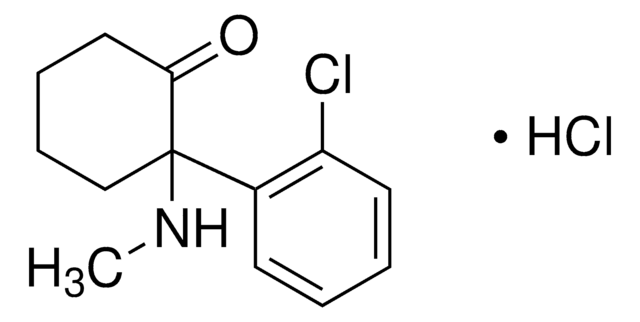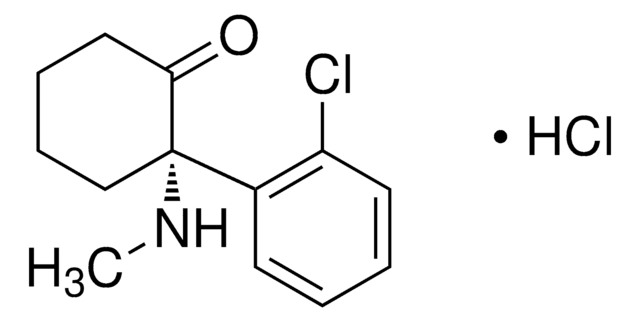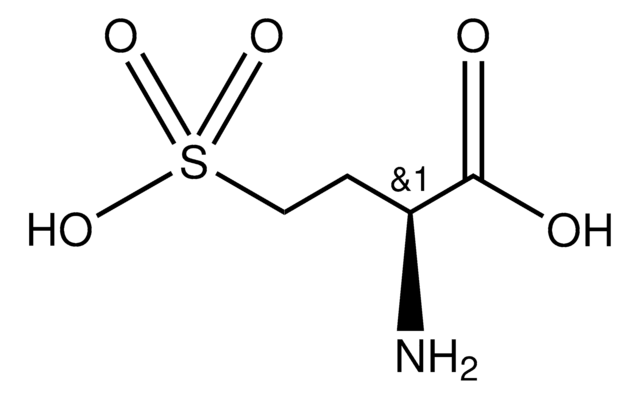P2926
Potassium tetrathionate
Synonym(s):
Tetrathionic acid dipotassium salt
Sign Into View Organizational & Contract Pricing
All Photos(3)
About This Item
Linear Formula:
KOSO2SSSO3K
CAS Number:
Molecular Weight:
302.45
EC Number:
MDL number:
UNSPSC Code:
12352302
PubChem Substance ID:
NACRES:
NA.23
Recommended Products
assay
≥98.0% (titration)
Quality Level
form
powder
density
2.96 g/mL at 25 °C (lit.)
storage temp.
2-8°C
SMILES string
[K+].[K+].[O-]S(=O)(=O)SSS([O-])(=O)=O
InChI
1S/2K.H2O6S4/c;;1-9(2,3)7-8-10(4,5)6/h;;(H,1,2,3)(H,4,5,6)/q2*+1;/p-2
InChI key
UVTKHPSJNFFIDG-UHFFFAOYSA-L
Looking for similar products? Visit Product Comparison Guide
General description
Potassium tetrathionate is a potassium salt of tetrathionic acid. Potassium tetrathionate is typically found as a white or off-white crystalline solid. It is soluble in water. We offer it for research purpose with a purity of ≥ 98 %. It is a sulfuric acid dimerformed by a disulfide linkage. It is widely used in the field of microbiology as aningredient for tetrathionate broth.
Application
Potassium tetrathionate, K2S4O6, is widely used in research and development (R&D), especially in the field of chemistry and biology. Some of the notable uses of it are : It acts as an oxidizing agent during chemical reactions. It readily reduces to thiosulfate which makes it a useful reducing agent in a wide range of oxidation-reduction systems. It can be used as a reagent in analytical methods in the determination of few compounds. For example: the iodometric determination of traces of iodine in solution. In Material Science it may be applied to the synthesis of sulfur containing material, or in the corrosion studies of metals by the sulfur compounds. In one of the studies, it has been used to test stress corrosion cracking of thermo-mechanically processed microstructures. It has been used as a precursor for electroless gold plating solution which is used in printed circuit boards (PCBs) to prevent Nickel corrosion. Catalysis: Due to its incorporation in redox processes, it could be employed for catalytical or co-catalytical purposes in some chemical reactions. Environmental Studies- It finds utility in environmental studies, for example in quantification of sulfur compounds in soil, water, and air samples. In biology, potassium tetrathionate may be used as a reagent in studies of sulfur metabolism in microorganisms. It has been used in studies concerning microbial sulfur oxidation pathways. It finds applications in textile industry as bleaching agent. Potassium tetrathionate (K2S4O6) can be used as an energy source for the batch culture of Acidithiobacillus caldus. K2S4O6 can be used as an additive (pit prevent agent) to prepare an electrolyte composition for electroplating of Cu-Sn alloy. It can also be used to study the adsorption competition of lead and sulfur on nickel in acidic aqueous media. K2S4O6 is preferred over other sulfur species as it is an acid-stable source of S and does not produce a large quantity of H2S.
Storage Class
11 - Combustible Solids
wgk_germany
WGK 1
flash_point_f
Not applicable
flash_point_c
Not applicable
ppe
dust mask type N95 (US), Eyeshields, Gloves
Choose from one of the most recent versions:
Already Own This Product?
Find documentation for the products that you have recently purchased in the Document Library.
Zhanna Bugaytsova et al.
European journal of biochemistry, 271(2), 272-280 (2004-01-14)
The moderately thermophilic bacterium Acidithiobacillus caldus is found in bacterial populations in many bioleaching operations throughout the world. This bacterium oxidizes elemental sulfur and other reduced inorganic sulfur compounds as the sole source of energy. The purpose of this study
the crystal structure of Potassium tetrathionate, K2S4O6
Stewart JM and Szymanski JT
Acta Crystallographica, B35, 1971-1974 (1979)
Engineered bacteria can function in the mammalian gut long-term as live diagnostics of inflammation.
David T Riglar et al.
Nature biotechnology, 35(7), 653-658 (2017-05-30)
Bacteria can be engineered to function as diagnostics or therapeutics in the mammalian gut but commercial translation of technologies to accomplish this has been hindered by the susceptibility of synthetic genetic circuits to mutation and unpredictable function during extended gut
Daniel B Grabarczyk et al.
PloS one, 12(3), e0173395-e0173395 (2017-03-04)
The Sox pathway found in many sulfur bacteria oxidizes thiosulfate to sulfate. Pathway intermediates are covalently bound to a cysteine residue in the carrier protein SoxYZ. We have used biochemical complementation by SoxYZ-conjugates to probe the identity of the intermediates
Kristina N-M Daeffler et al.
Molecular systems biology, 13(4), 923-923 (2017-04-05)
There is a groundswell of interest in using genetically engineered sensor bacteria to study gut microbiota pathways, and diagnose or treat associated diseases. Here, we computationally identify the first biological thiosulfate sensor and an improved tetrathionate sensor, both two-component systems
Our team of scientists has experience in all areas of research including Life Science, Material Science, Chemical Synthesis, Chromatography, Analytical and many others.
Contact Technical Service








